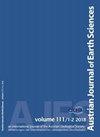奥地利维也纳盆地Roman Carnuntum和Vindobona腹地中新世石灰岩采石场地质遥感找矿
IF 1.1
4区 地球科学
Q2 Earth and Planetary Sciences
引用次数: 1
摘要
我们记录了维也纳盆地(奥地利)、Hundsheim山脉、Leitha山脉和Rust Hills中新世石灰岩采石场的高分辨率机载激光扫描数据和正射影像图,旨在建立自罗马时期以来采石场的历时性库存。将研究区划分为6个采石场区,分析了整个研究区和每个单独区域的采石场在不同的岩石类型、平均、最小和最大采石场面积以及不同地图上的发展情况。从历史地图、历史摄影和绘画以及采石场面部涂鸦中寻找年龄信息。在详细的数字地形模型中,总共列出了658个采石场、可能的采石场和浅层采石场,并与1754年至1872年间四代历史地图中显示的453个采石场进行了比较。在沃尔特地图(1754-1756年)、第一次军事调查(1773-1785年)和第二次军事调查(1809-1846年)中,采石场的数量普遍较低,但在第三次军事调查(1872-1873年)的地图中,采石场的数量急剧增加。大多数古老的采石场在随后的时期也被采石,通常摧毁了几乎所有先前存在的痕迹。根据我们的研究结果,两种类型的采石场代表了在寻找罗马采石场的更详细研究中非常有趣的目标:(i)在历史地图上有可疑的不平坦地形的地区,这些地区从未被概述为采石场,以及被绘制为“旧采石场”的地区-特别是在第三次军事调查中;例如下奥地利州巴德-阿尔滕堡的Pfaffenberg西北和西部地区,布尔根州的Winden am See的“Gruibert”和布尔根州Stotzing的“Hoher Berg”;浅层采石场,既没有出现在历史地图上,也没有出现在奥地利地质调查局的采矿档案中,如在普法芬贝格和亨兹海默贝格之间的马鞍上的采石场。本文章由计算机程序翻译,如有差异,请以英文原文为准。
Geoarchaeological remote sensing prospection of Miocene limestone quarries in the hinterland of Roman Carnuntum and Vindobona (Vienna Basin, Austria)
Abstract We have documented quarries in Miocene limestone in the Vienna Basin (Austria), Hundsheim Mountains, Leitha Mountains and Rust Hills in high-resolution airborne laser scanning data and orthophotos aiming for a diachronic quarry inventory since the Roman period. The study region was divided into 6 quarry regions and the quarries of the whole study area as well as each separate region were analyzed concerning different rock types, mean, minimum and maximum quarry area and development in the different maps. Age information have been sought from historical maps, historical photography and paintings as well as quarry face graffiti. In total, 658 quarries, possible quarries and shallow quarries have been outlined in the detailed digital terrain models, which were compared with 453 quarries indicated in four generations of historical maps between the years 1754 to 1872. The numbers of quarries are generally low in the Walter map (1754–1756), the First Military Survey (1773–1785) and Second Military Survey (1809–1846) but increase tremendously in the maps of the Third Military Survey (1872–1873). Most old quarries were quarried also in subsequent periods, commonly destroying virtually all pre-existing traces. According to our results two types of quarries represent highly interesting targets for more detailed studies in the search for Roman quarries: (i) areas in historical maps with suspicious uneven terrain, which have never been outlined as quarries and areas that have been mapped as “old quarries” – especially in the Third Military Survey; examples represent areas northwest and west of Pfaffenberg in Bad Deutsch-Altenburg (Lower Austria), “Gruibert” in Winden am See (Burgenland) and “Hoher Berg” in Stotzing (Burgenland); (ii) Shallow quarries, which neither appear in historical maps nor in the mining archive of the Geological Survey of Austria like the one from the saddle between Pfaffenberg and Hundsheimer Berg.
求助全文
通过发布文献求助,成功后即可免费获取论文全文。
去求助
来源期刊

Austrian Journal of Earth Sciences
Earth and Planetary Sciences-Paleontology
CiteScore
3.10
自引率
0.00%
发文量
0
审稿时长
>12 weeks
期刊介绍:
AUSTRIAN JOURNAL OF EARTH SCIENCES is the official journal of the Austrian Geological, Mineralogical and Palaeontological Societies, hosted by a country that is famous for its spectacular mountains that are the birthplace for many geological and mineralogical concepts in modern Earth science.
AUSTRIAN JOURNAL OF EARTH SCIENCE focuses on all aspects relevant to the geosciences of the Alps, Bohemian Massif and surrounding areas. Contributions on other regions are welcome if they embed their findings into a conceptual framework that relates the contribution to Alpine-type orogens and Alpine regions in general, and are thus relevant to an international audience. Contributions are subject to peer review and editorial control according to SCI guidelines to ensure that the required standard of scientific excellence is maintained.
 求助内容:
求助内容: 应助结果提醒方式:
应助结果提醒方式:


